American Bank Note Company print runs
The American Bank Note Company produced the following notes. The company engraved the portrait of governor Ramón Corral's daughter, Hortensia (C 221) for all the face plates, and this vignette was approved on 21 December 1897.
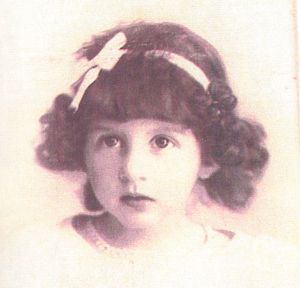
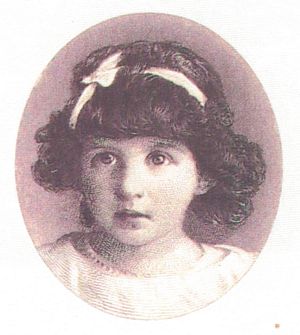
The $5 face plate, $5 back plate (6 notes on each) and two $5 tint plates No. 1 and 2 (1 note); the $10 face plate, $10 back plate (4 notes on each) and two $10 tint plates No. 1 and 2 (1 note); the $20 face plate, $20 back plate (4 notes on each) and two $20 tint plates No. 1 and 2 (1 note); the $50 face plate, $50 back plate (4 notes on each) and two $50 tint plates No. 1 and 2 (1 note) ; and the $100 face plate, $100 back plate (1 note on each) and two $100 tint plates No. 1 and 2 (1 note) were all recorded as engraved on 24 November 1897. The design for the $5 was approved by Juan de Dios Castro on 7 February 1898. The design for the $10 was approved by Rafael Ruíz on 21 February 1898. The designs for the $20, the $50 and the $100 were approved by Max Müller on 18 March 1898.
The sequence of serial letters for the issue of the different series shows that the bank progressed through the alphabet, across all the denominations; then issued the series A1, B1, C1 and D1; then used the alphabet again for each value. Finally the bank began to use double letters.
The very earliest notes had the reverse design printed on a white background with the legend ‘EL BANCO DE SONORA’.
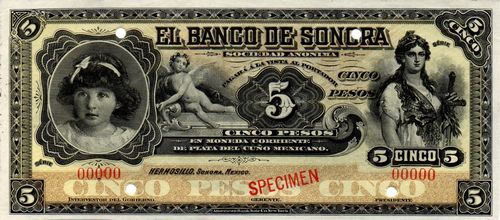
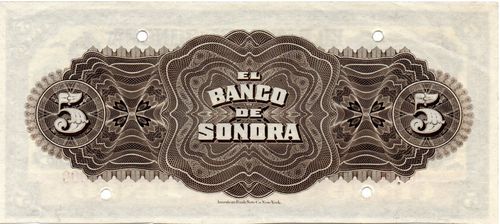 M507s1 $5 Banco de Sonora specimen
M507s1 $5 Banco de Sonora specimen
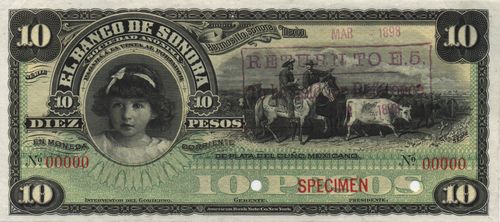
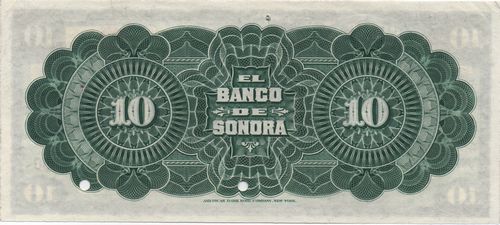 M508s1 $10 Banco de Sonora specimen
M508s1 $10 Banco de Sonora specimen
| Date | Value | Number | Series | from | to |
| November 1897 | $5 | 30,000 |
1 | 30000 | |
| $10 | 15,000 |
1 | 15000 | ||
| $20 | 7,500 |
1 | 7500 | ||
| $50 | 3,000 |
1 | 3000 | ||
| $100 | 1,500 |
1 | 1500 |
On 10 April 1899 the legend on the reverse of the $5 and $10 notes was changed to ‘BANCO DE SONORA’.
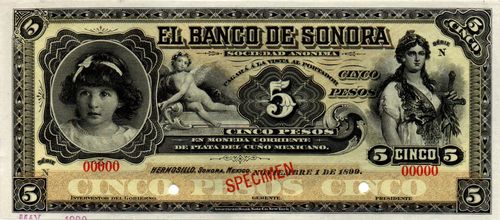
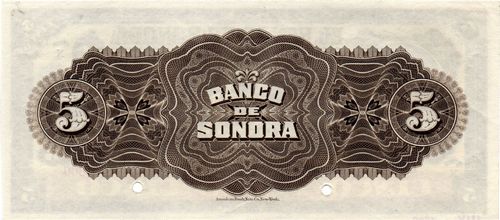 M507s1 $5 Banco de Sonora specimen
M507s1 $5 Banco de Sonora specimen
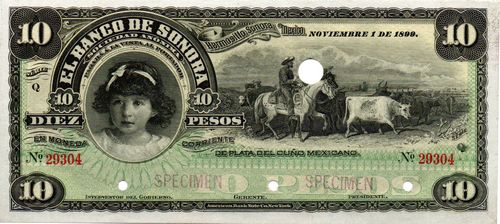
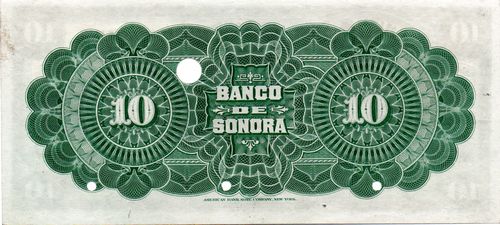 M508s1 $10 Banco de Sonora specimen
M508s1 $10 Banco de Sonora specimen
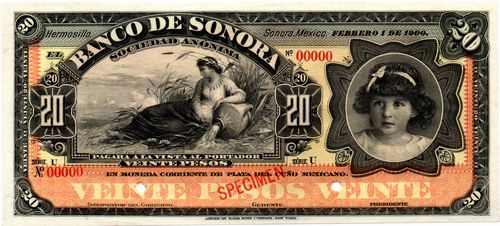
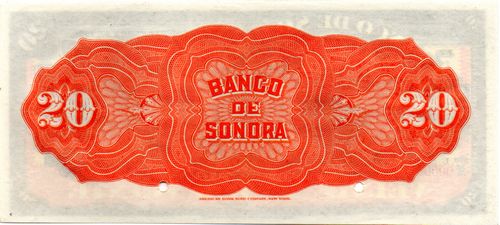 M509s1 $20 Banco de Sonora specimen
M509s1 $20 Banco de Sonora specimen
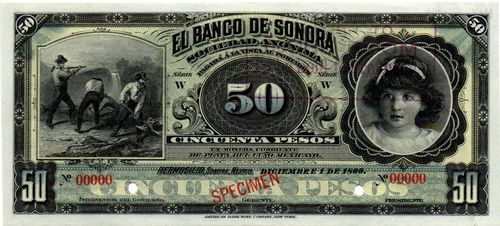
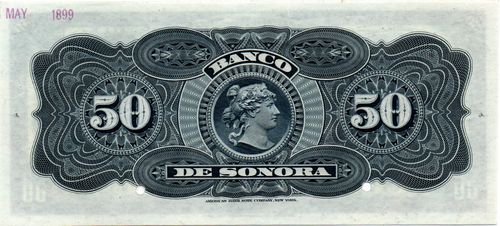 M5010s1 $50 Banco de Sonora specimen
M5010s1 $50 Banco de Sonora specimen
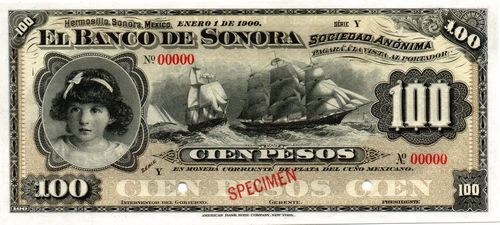
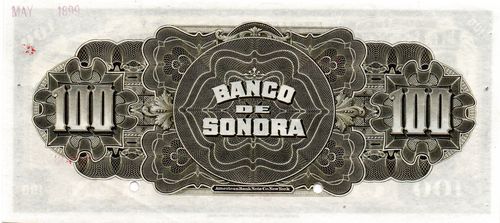 M511s1 $100 Banco de Sonora specimen
M511s1 $100 Banco de Sonora specimen
| Date | Value | Number | Series | from | to |
| April 1899 | $5 | 40,000 |
30001 | 70000 | |
| $10 | 20,000 |
15001 | 35000 | ||
| $20 | 7,500 |
7501 | 15000 | ||
| $50 | 2,000 |
3001 | 5000 | ||
| $100 | 1,000 |
1501 | 2500 |
From 25 May 1901 all denominations had a cycloid pattern covering all the white space on the reverse. The May 1901 print run had the date 'JULIO 1 DE 1901'.
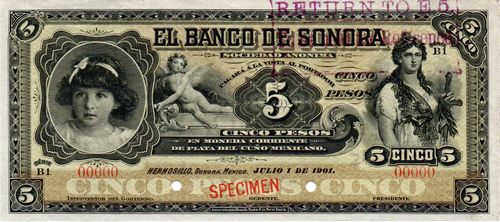
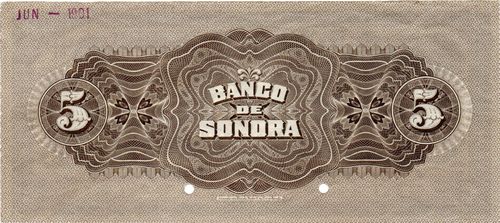 M507s2 $5 Banco de Sonora specimen
M507s2 $5 Banco de Sonora specimen
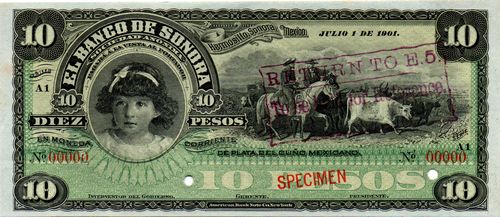
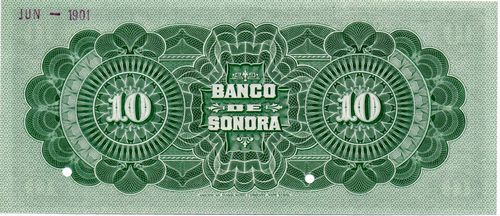 M508s2 $10 Banco de Sonora specimen
M508s2 $10 Banco de Sonora specimen
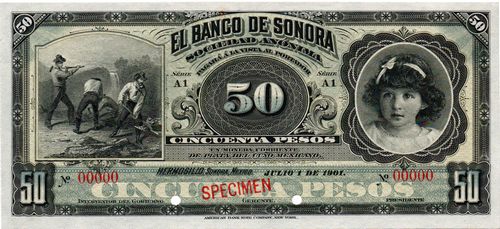
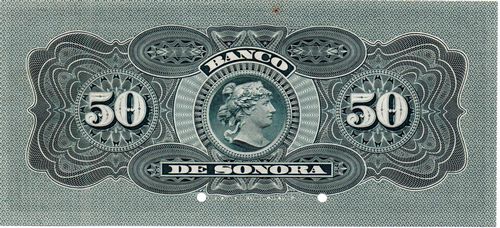 M510s2 $50 Banco de Sonora specimen
M510s2 $50 Banco de Sonora specimen
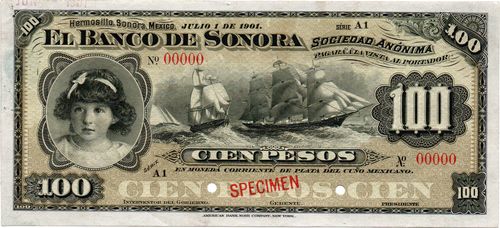
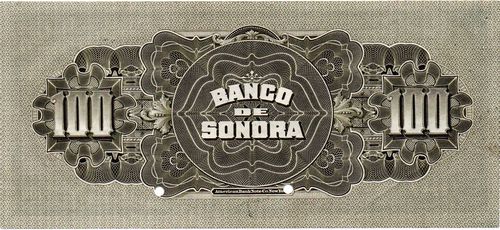 M511s21 $100 Banco de Sonora specimen
M511s21 $100 Banco de Sonora specimen
| Date | Value | Number | Series | from | to |
| May 1901 | $5 | 40,000 |
70001 | 110000 | |
| $10 | 20,000 |
35001 | 55000 | ||
| $20 | 7,500 |
15001 | 22500 | ||
| $50 | 2,000 |
5001 | 7000 | ||
| $100 | 1,000 |
2501 | 3500 |
The May 1902 print run had the date 'JULIO 1 DE 1902'.
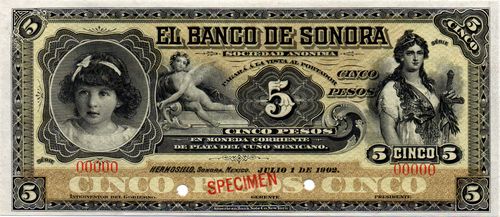 M507s2 $5 Banco de Sonora specimen
M507s2 $5 Banco de Sonora specimen
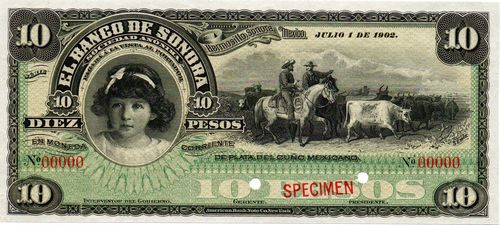 M508s2 $10 Banco de Sonora specimen
M508s2 $10 Banco de Sonora specimen
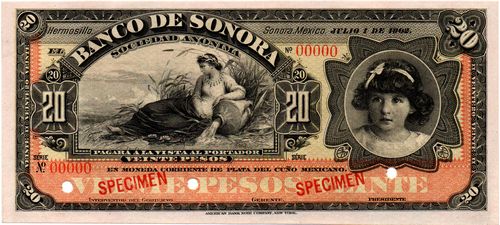 M509s2 $20 Banco de Sonora specimen
M509s2 $20 Banco de Sonora specimen
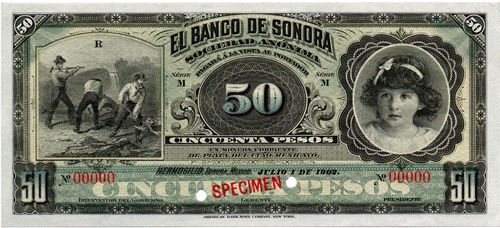 M510s2 $50 Banco de Sonora specimen
M510s2 $50 Banco de Sonora specimen
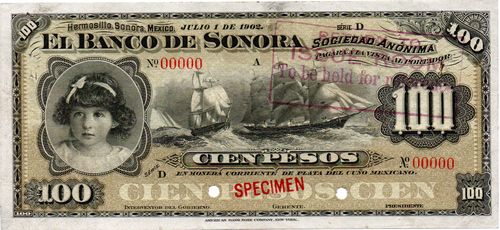 M511s2 $100 Banco de Sonora specimen
M511s2 $100 Banco de Sonora specimen
| Date | Value | Number | Series | from | to |
| May 1902 | $5 | 40,000 |
110001 | 150000 | |
| $10 | 20,000 |
55001 | 75000 | ||
| $20 | 7,500 |
22501 | 30000 | ||
| $50 | 2,000 |
7001 | 9000 | ||
| $100 | 1,000 |
3501 | 4500 |
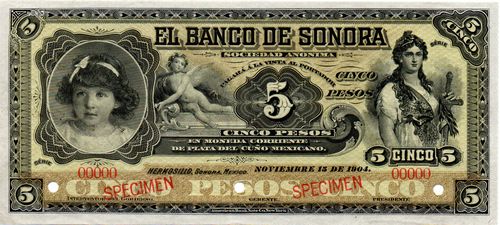 M507s2 $5 Banco de Sonora specimen
M507s2 $5 Banco de Sonora specimen
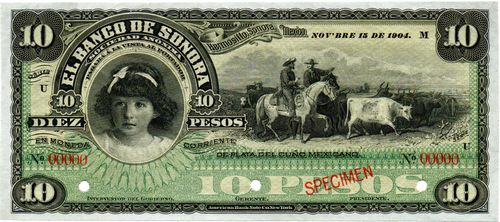 M508s2 $10 Banco de Sonora specimen
M508s2 $10 Banco de Sonora specimen
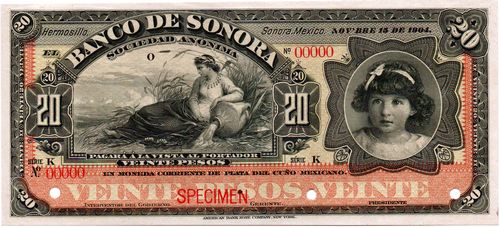 M509s2 $20 Banco de Sonora specimen
M509s2 $20 Banco de Sonora specimen
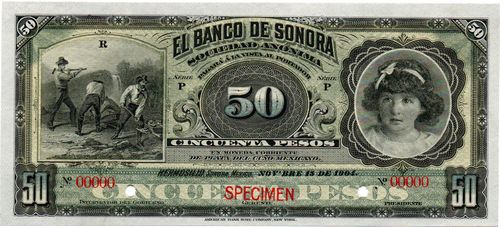 M510s2 $50 Banco de Sonora specimen
M510s2 $50 Banco de Sonora specimen
| Date | Value | Number | Series | from | to |
| September 1904 | $5 | 20,000 |
T-X | 150001 | 170000 |
| $10 | 7,000 |
S-V | 75001 | 82000 | |
| $20 | 2,500 |
J-K | 30001 | 32500 | |
| $50 | 1,000 |
O-P | 9001 | 10000 | |
| $100 | 300 |
J-K | 4501 | 4800 |
On 11 November 1904 ABNC shipped by Wells Fargo, via Laredo, to the Banco Central Mexicano in Mexico City, a box containing 20,000 $5 notes (T 150001-154000, U 154001-158000, V 158001-162000, W 162001-160000; X 166001-170000); 7,000 $10 notes (S 75001-77000; T 77001-79000, U 79001-81000, V 81001-82000); 1,000 $50 notes (O 9001-9500, P 9501-10000); and 300 $100 notes (J 4501-4700, K 4701-4800). They did not include any $20 notes as they spoiled a large part of these in the printing. So, on 2 December they sent the 2,500 $20 notes (J 30001-32000, K 32001-32500).
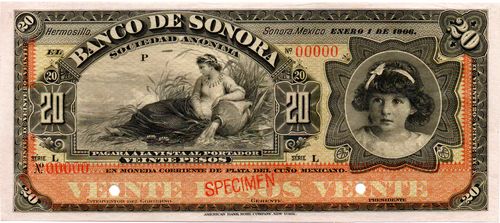 M509s2 $20 Banco de Sonora specimen
M509s2 $20 Banco de Sonora specimen
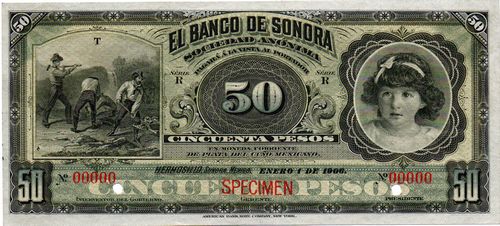 M510s2 $50 Banco de Sonora specimen
M510s2 $50 Banco de Sonora specimen
 M511s2 $100 Banco de Sonora specimen
M511s2 $100 Banco de Sonora specimen
| Date | Value | Number | Series | from | to |
| October 1905 | $5 | 40,000 |
AQ-AZ | 170001 | 210000 |
| $10 | 15,000 |
W-Z, AW-AZ | 82001 | 97000 | |
| $20 | 7,000 |
L-O | 32501 | 39500 | |
| $50 | 1,200 |
Q-S | 10001 | 11200 | |
| $100 | 500 |
L-N | 4801 | 5300 |
On 26 December 1905 ABNC consigned by Adams Express (via Laredo) to the Banco Central Mexicano, one box, No. 1, containing 40,000 $5 notes (AZ 170001-174000, AY 174001-178000, AX 178001-182000, AW 1820001-186000, AV 186001-190000, AU 190001-194000, AT 194001-198000, AS 198001-202000, AR 202001-206000, and AQ 206001-210000) and another box, No. 2, containing 15,000 $10 notes (W 82001-84000, X 84001-86000, Y 86001-88000, Z 88001-90000, AZ 90001-92000, AY 92001-94000, AX 94001-96000, AW 96001-97000); 7,000 $20 notes (L 32501-34500, M 34501-26500, N 36501-38500, O 38501-39500); 1,200 $50 notes (Q 10001-10400, R 10401-10800, S 10800-112000), and 500 $100 notes (L 4801-5000, M 5001-5200, N 5201-5300).
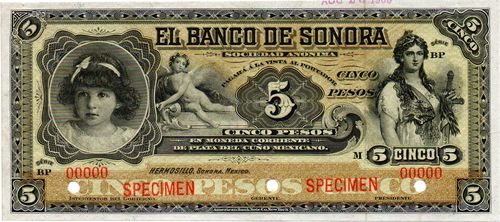 M507s2 $5 Banco de Sonora specimen
M507s2 $5 Banco de Sonora specimen
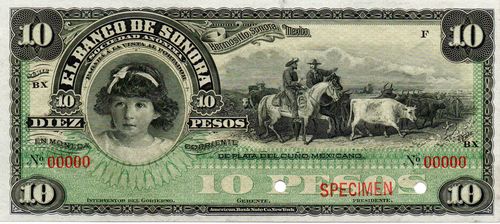 M508s2 $10 Banco de Sonora specimen
M508s2 $10 Banco de Sonora specimen
 M511s2 $100 Banco de Sonora specimen
M511s2 $100 Banco de Sonora specimen
| Date | Value | Number | Series | from | to |
| August 1909 | $5 | 40,000 |
210001 | 250000 | |
| $10 | 15,000 |
97001 | 112000 | ||
| $20 | 7,000 |
39501 | 46500 | ||
| $50 | 1,200 |
11201 | 12400 | ||
| $100 | 500 |
5301 | 5800 |
The ABNC had some notes ready by 30 October but decided, as it was a small order, to make a single shipment. During the first week of November the bank was asking when it would receive its notes, and on 9 November was told that all would be shipped on 13 November. However, the bank must have been in dire need as it replied, on 9 November, that the ABNC should ship whatever it had. The next day the ABNC said that it would ship six series of $5 noes and all the $20 notes, and so, on 12 November the ABNC shipped, through Wells Fargo Express, a box with 24,000 $5 notes (BM 210001-214000, BN 214001-218000, BO 218001-222000, BP 222001-226000, BQ 226001-230000, BR 230001-234000), and 7,000 $20 notes (BT 39501-41500, BU 41501-43500, BV 43501-45500, BW 45501-46500). On 16 November it sent 16,000 $5 notes (BJ 234001-238000, BH 238001-242000, BG 242001-246000, BF 246001-250000); 15,000 $10 notes (BX 97001-99000, BW 99001-101000, BV 101001-103000, BU 103001-105000, BT 105001-107000, BS 107001-109000, BR 109001-111000, BQ 111001-112000); 1,200 $50 notes (CA 11201-11600, CB 11601-12000, CC 12001-12400); and 500 $100 notes (CD 5301-5500, CE 5501-5700, CF 5701-5800)ABNC, folder 197, Banco de Sonora (1904-1910).
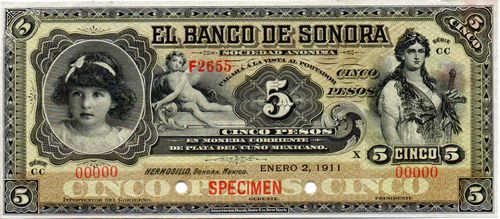 M507s2 $5 Banco de Sonora specimen
M507s2 $5 Banco de Sonora specimen
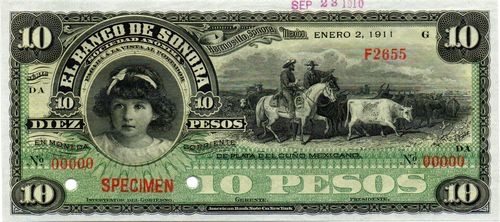 M508s2 $10 Banco de Sonora specimen
M508s2 $10 Banco de Sonora specimen
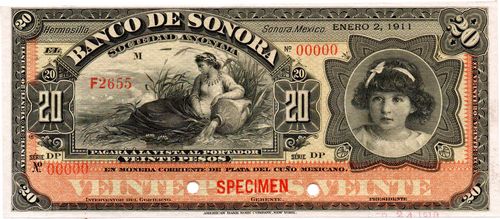 M509s2 $20 Banco de Sonora specimen
M509s2 $20 Banco de Sonora specimen
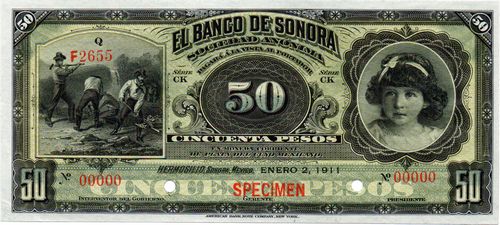 M510s2 $50 Banco de Sonora specimen
M510s2 $50 Banco de Sonora specimen
| Date | Value | Number | Series | from | to |
| September 1910 | $5 | 70,000 |
250001 | 320000 | |
| $10 | 30,000 |
112001 | 142000 | ||
| $20 | 16,000 |
46501 | 62500 | ||
| $50 | 10,000 |
12401 | 22400 | ||
| $100 | 2,000 |
5801 | 7800 |
On 5 December 1910 the ABNC shipped 8,000 $5 notes (CA 25001-254000, CB 254001-258000) and 3,000 $10 notes (DA 112001-115000). On 23 December box No. 6 contained 8,000 $5 notes (CC 258001-262000, CD 262001-266000, CE 266001-270000, CF 270001-274000, CG 274001-278000, CH 278001-282000, CJ 282001-286000), 9,000 $10 notes ( DB 115001-118000, DC 118001-121000, DD 121001-124000); 16,000 $20 notes (DL 46501-48500, DM 48501-50500, DN 50501-52500, DO 52501-54500, DP 54501-56500, DQ 56501-58500, DR 58501-60500, DS 60501-62500), and 2,000 $100 notes (CG 5801-6000, CH 6001-6200, CJ 6201-6400, CK 6401-6600, CL 6601-6800, CM 6801-7000, CN 7001-7200, CO 7201-7400, CP 7401-7600, CQ 7601-7800).
On 16 January 1911 the ABNC shipped, in box No. 7, 34,000 $5 notes (CK 286001-290000, CL 290001-294000, CM 294001-298000, CN 298001-302000, CO 302001-306000, CP 306001-310000, CQ 310001-314000, CR 314001-318000, CS 318001-320000) and in box No. 8, 18,000 $10 notes (DE 124001-127000, DF 127001-130000, DG 130001-133000, DH 133001-136000, DJ 136001-139000, DK 139001-142000), and 10,000 $50 notes (CD 12401-13400, CE 13401-14400, CF 14401-15400, CG 15401-16400, CH 16401-17400, CJ 17401-18400, CK 18401-19400, CL 19401-20400, CM 20401-21400, CN 21401-22400).
On 6 September 1912 the bank ordered another 128,000 notes:
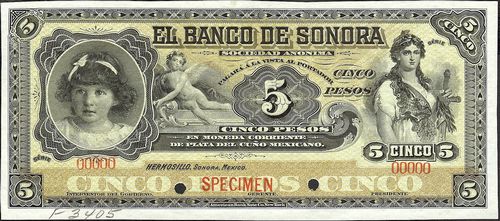 M507s2 $5 Banco de Sonora specimen
M507s2 $5 Banco de Sonora specimen
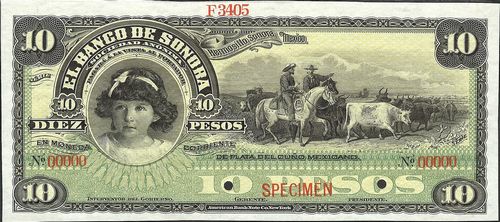 M508s2 $10 Banco de Sonora specimen
M508s2 $10 Banco de Sonora specimen
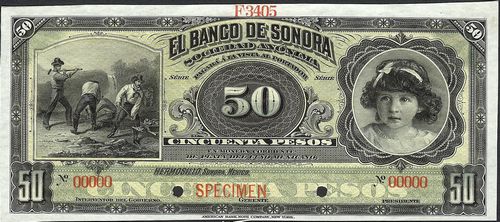 M510s2 $50 Banco de Sonora specimen
M510s2 $50 Banco de Sonora specimen
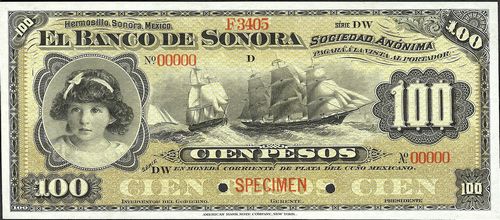 M511s2 $100 Banco de Sonora specimen
M511s2 $100 Banco de Sonora specimen
| Date | Value | Number | Series | from | to |
| September 1912 | $5 | 70,000 |
320001 | 390000 | |
| $10 | 30,000 |
142001 | 172000 | ||
| $20 | 16,000 |
62501 | 78500 | ||
| $50 | 10,000 |
12401 | 32400 | ||
| $100 | 2,000 |
7801 | 9800 |
On 11 January 1913 the ABNC shipped via Wells Fargo Express, to the Banco Central Mexicano in Mexico City, in box No. 9, 12,000 $10 notes (DL 142001-145000, DM 145001-148000, DN 148001-151000, DO 151001-154000).
On 7 Febuary it shipped, in box No 10, 70,000 $5 notes (DH 320001-324000, DI 324001-328000, DK 328001-332000, DL 332001-336000, DM 336001-340000, DN 340001-344000, DO 344001-348000, DP 348001-352000, DQ 352001-356000, DR 356001-360000, DS 360001-364000, DT 364001-368000, DU 368001-372000, DV 372001-376000, DW 376001-380000, DX 380001-384000, DY 384001-388000, Dz 388001-390000), and in box No. 11, 18,000 $10 notes (DP 154001-157000, DQ 157001-160000, DR 160001-163000, DS 163001-166000, DT 166001-169000, and DU 169001-172000), 16,000 $20 notes (DT 62501-64500, DU 64501-66500, DV 66501-68500, DW 68501-70500, DX 70501-72500, DY 72501-74500, DZ 74501-76500, DA 76501-78500), 10,000 $50 notes (DO 22401-23400, DP 23401-24400, DQ 24401-25400, DR 25401-26400, DS 26401-27400, DT 27401-28400, DU 28401-29400, DV 29401-30400, DW 30401-31400, DX 31401-32400) and 2,000 $100 notes (DR 7801-8000, DS 8001-8200, DT 8201-8400, DU 8401-8600, DV 8601-8800, DW 8801-9000, DX 9001-9200, DY 9201-9400, DZ 9401-9600, DA 9601-9800).
On 13 February the bank wired the ABNC to tell them not to send any more notes until further notice, but the ABNC had already dispatched the balance in two boxes on 7 February. On 17 June the ABNC telegraphed the bank in Hermosillo to ask whether it had received the notes and the bank replied that it had had no mail at Hermosillo since 3 March and did not know if the notes had arrived in Mexico City. The printers therefore asked Wells Fargo to trace the consignments and on 6 September Wells Fargo reported that the first shipment had been delivered on 21 June. Finally, on 16 December, Wells Fargo was able to confirm that the second consignment had been delivered to the Banco Central Mexicano on 19 FebruaryABNC, folder 197, Banco de Sonora (1904-1910).
These notes were never sealed by the Secretaría de Hacienda or put into circulation. It is not known how they made their way back to the United States but somehow they were offloaded by the Banco de Sonora. They were used as movie money (see Movie money) and also found their way to coin dealers.
The plates were cancelled on 28 August 1931The remaining plates were one $5 face plate (#5) made on order F 3405, two $5 back plates (#3 made on order F 2148 and #4 made on order F 3405) and two $5 tint plates, No. 1 and 2: one $10 face plate (#3) made on order F 2655 and one $10 back plate (#1 made on order of 10 April 1899) and two $10 tint plates No. 1 and 2: one $20 face plate (#2) made on order F 32, one $20 back plate (#1 made on order of 24 November 1897) and two $20 tint plates, No. 1 and 2: one $50 face plate (#2) made on order F 2655 and one $50 back plate (#2 made on order F 2655) and two $50 tint plates, No. 1 and 2; and one $100 face plate made on order of 24 November 1897 and one $100 back plate made on order of 24 November 1897 and two $100 tint plates, No. 1 and 2. (ABNC, folder 197, Banco de Sonora (1911-1931)).
